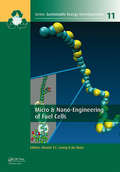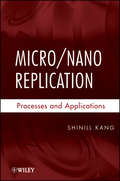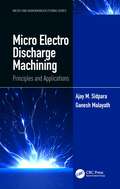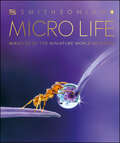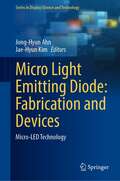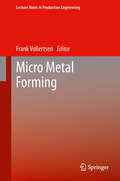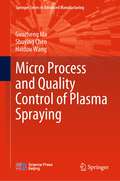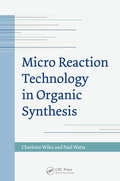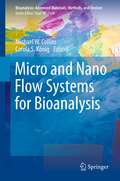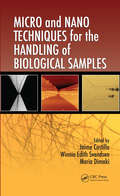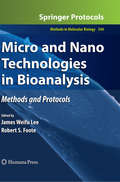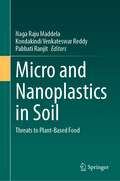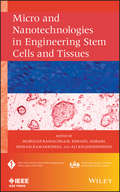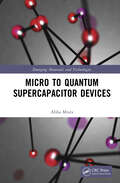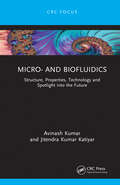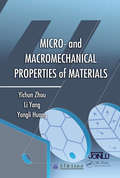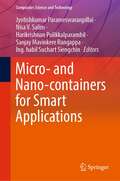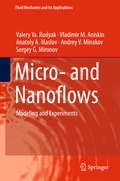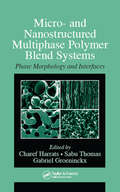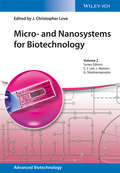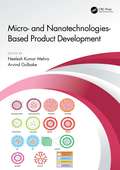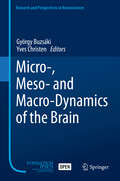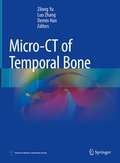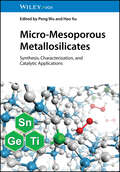- Table View
- List View
Micro & Nano-Engineering of Fuel Cells (Sustainable Energy Developments)
by Jin Xuan Dennis Y.C. LeungFuel cells are clean and efficient energy conversion devices expected to be the next generation power source. During more than 17 decades of research and development, various types of fuel cells have been developed with a view to meet the different energy demands and application requirements. Scientists have devoted a great deal of time and effort
Micro / Nano Replication
by Shinill KangAn introduction to micro and nano replication processes and applicationsMicro/Nano Replication: Processes and Applications provides an overview of the fundamentals, processes, and applications involved in micro and nano replication in the manufacturing of product parts. A major field of nanotechnology, the study of micro/nano replication is sure to become one of increasing importance as the construction of completely new devices based on innovative concepts and crafted at the molecular level increases.Designed to help the reader understand and learn to work with the growing number of tools for molding plastic components, the book covers the key topics related to replication, including patterning technology, the modification of mold surface properties, and much more. In addition, it addresses the strengths and weaknesses of different molding processes.With a strong focus not only on how micro/nano replication works, but also the broader implications for the industry, the book is packed with examples of real world applications. These are drawn from a variety of fields, including information storage devices, optoelectronic elements, optical communication, and biosensors, in order to provide a complete view of the importance of micro and nano processes.A valuable introduction to a new but fast-growing field, Micro/Nano Replication is an essential resource for anyone looking to get a head start on understanding this emerging discipline.
Micro Electro Discharge Machining: Principles and Applications (Micro and Nanomanufacturing Series)
by Ajay M. Sidpara Ganesh MalayathMicro Electro Discharge Machining (EDM) is a prominent technology for the fabrication of micro components in many fields. Nowadays, it is used like a conventional machine tool due to favorable characteristics. This book provides the fundamental knowledge of the principles of the process and its variants, the different process parameters, the role of machine components and systems, the challenges, and how to eliminate processing errors. It also includes real life applications of micro EDM in different areas with the most relevant examples.
Micro Life: Miracles of the Miniature World Revealed (DK Secret World Encyclopedias)
by DKExplore the miracles of the microscopic world.Find out all about the unique and beautiful kingdoms of life at a microscopic scale and how every organism meets the challenges of survival no matter its size. The perfect book for people who enjoy photography, nature and biology.Inside the pages of this exciting educational nature book, you&’ll find: • Microscopic life-forms (often neglected), and their life-forms in extreme close-ups, revealing details such as nerve cells and hair follicles. • Artworks support the beautiful images, providing a deeper insight into structure and function and building a picture of how living organisms work at a microscopic level. • Comprehensive coverage of the natural world, including all the main groups of living things. • Explores overlooked groups that have a huge role in the natural world: insects, which make up 80% of the world&’s animal species, and bacteria — of which there are more in a human mouth than there are people in the world. • The book is organized according to the main functions of life: movement, reproduction, energy and feeding, sensing the surroundings, defense, etc. • Optional 80-page section containing a catalog of the major kingdoms of life. The beauty of nature under a microscopeExplore the inhabitants of an invisible world in incredible detail with this book, which contains macro photography and spectacular microscope imagery. You'll have so much information about the hidden world of intricate structures beyond the naked eye. From the tiniest spiders and insects to even microscopic creatures like bacteria and viruses, this book contains it all!See the beauty of a pollen grain, a butterfly egg, the spore of a fungus and a human&’s nerve cell in extreme close up. The amazing imagery in Micro Life contains focus-stacked macro photographs and micrographs (microscope images), including scanning electron micrographs. Illustrations in this book explain the science — from the workings of an insect&’s eye to how a plant &“breathes&” through its leaves. Micro Life is an unexpectedly breathtaking look at the natural world. Find out how life works and how organisms solve the fundamental problems of movement, reproduction, energy, communication and defense. This book belongs on the bookshelves of schools, libraries and homes for those interested in photography, nature or biology.
Micro Light Emitting Diode: Micro-LED Technology (Series in Display Science and Technology)
by Jong-Hyun Ahn Jae-Hyun KimThis book focuses on basic fundamental and applied aspects of micro-LED, ranging from chip fabrication to transfer technology, panel integration, and various applications in fields ranging from optics to electronics to and biomedicine. The focus includes the most recent developments, including the uses in large large-area display, VR/AR display, and biomedical applications. The book is intended as a reference for advanced students and researchers with backgrounds in optoelectronics and display technology. Micro-LEDs are thin, light-emitting diodes, which have attracted considerable research interest in the last few years. They exhibit a set of exceptional properties and unique optical, electrical, and mechanical behaviors of fundamental interest, with the capability to support a range of important exciting applications that cannot be easily addressed with other technologies. The content is divided into two parts to make the book approachable to readers of various backgrounds and interests. The first provides a detailed description with fundamental materials and production approaches and assembly/manufacturing strategies designed to target readers who seek an understanding ofof essential materials and production approaches and assembly/manufacturing strategies designed to target readers who want to understand the foundational aspects. The second provides detailed, comprehensive coverage of the wide range of device applications that have been achieved. This second part targets readers who seek a detailed account of the various applications that are enabled by micro-LEDs.
Micro Metal Forming
by Frank VollertsenMicro Metal Forming, i. e. forming of parts and features with dimensions below 1 mm, is a young area of research in the wide field of metal forming technologies, expanding the limits for applying metal forming towards micro technology. The essential challenges arise from the reduced geometrical size and the increased lot size. In order to enable potential users to apply micro metal forming in production, information about the following topics are given:tribological behavior: friction between tool and work piece as well as tool wearmechanical behavior: strength and formability of the work piece material, durability of the work pieces size effects: basic description of effects occurring due to the fact, that the quantitative relation between different features changes with decreasing size process windows and limits for forming processestool making methodsnumerical modeling of processes and process chainsquality assurance and metrologyAll topics are discussed with respect to the questions relevant to micro metal forming. The description comprises information from actual research and the young history of this technology branch to be used by students, scientists and engineers in industry who already have a background in metal forming and like to expand their knowledge towards miniaturization. tribological behavior: friction between tool and work piece as well as tool wearmechanical behavior: strength and formability of the work piece material, durability of the work pieces size effects: basic description of effects occurring due to the fact, that the quantitative relation between different features changes with decreasing size process windows and limits for forming processestool making methodsnumerical modeling of processes and process chainsquality assurance and metrologyAll topics are discussed with respect to the questions relevant to micro metal forming. The description comprises information from actual research and the young history of this technology branch to be used by students, scientists and engineers in industry who already have a background in metal forming and like to expand their knowledge towards miniaturization.
Micro Process and Quality Control of Plasma Spraying (Springer Series in Advanced Manufacturing)
by Haidou Wang Guozheng Ma Shuying ChenThis book focuses on the basic physical process and chemical reaction of plasma spraying particle melting, flight and deposition. It introduces the basic scientific contents such as the basic characteristics and spraying principle of plasma arc, the interaction between spraying particles in flight section and plasma jet, the spreading and solidification behavior of single droplet and the performance test of flat particles, macro performance evaluation and quality optimization of coating. The typical applications of plasma spraying coating and the new developing direction of plasma spraying technology are summarized. This book will be helpful for the graduate students, researchers, as well as engineers in the field of plasma spray.
Micro Reaction Technology in Organic Synthesis
by Paul Watts Charlotte WilesWhile continuous processes have found widespread application within chemical production, members of the research and development communities have historically favored the centuries old technique of iterative batch reactions. With the exception of combinatorial and microwave chemistry, little had been done to change the way that synthetic chemists c
Micro and Nano Flow Systems for Bioanalysis
by Michael W. Collins Carola S. KoenigMicro and Nano Flow Systems for Bioanalysis addresses the latest developments in biomedical engineering at very small scales. It shows how organic systems require multi-scale understanding in the broadest sensewhether the approach is experimental or mathematical, and whether the physiological state is healthy or diseased. Micro-and nano-fluidics represent key areas of translational research in which state-of-the-art engineering processes and devices are applied to bedside monitoring and treatment. By applying conventional micro- and nano-engineering to complex organic solids, fluids, and their interactions, leading researchers from throughout the world describe methods and techniques with great potential for use in medicine and clinical practice. Coverage includes the seeming plethora of new, fine-scale optical methods for measuring blood flow as well as endothelial activation and interaction with tissue. Generic areas of modeling and bioelectronics are also considered. In keeping with the recurring theme of medicine and clinical practice, approximately half of the chapters focus on the specific application of micro- and nano- flow systems to the understanding and treatment of cancer and cardiovascular diseases. This book developed from an Expert Overview Session on "Micro & Nano Flows in Medicine: the way ahead" at the 3rd Micro and Nano Flows Conference (MNF2011) held in Thessaloniki, Greece. Additional chapters were included to enhance the international, state-of-the-art coverage.
Micro and Nano Techniques for the Handling of Biological Samples
by Jaime Castillo-Leon Winnie Edith Svendsen Maria DimakiSeveral micro- and nanomanipulation techniques have emerged in recent decades thanks to advances in micro- and nanofabrication. For instance, the atomic force microscope (AFM) uses a nano-sized tip to image, push, pull, cut, and indent biological material in air, liquid, or vacuum. Using micro- and nanofabrication techniques, scientists can make ma
Micro and Nano Technologies in Bioanalysis
by James W. Lee Robert S. FooteIn recent years, large-scale advances in technology have led to greater understanding of the world on a much tinier scale: the biomolecular level. In Micro and Nano Technologies in Bioanalysis: Methods and Protocols, expert researchers from across the globe explore the technology which makes this analysis possible, investigating the worlds of microfluidics and nanotechnologies, and examining physical science techniques for the separation, detection, manipulation, and analysis of biomolecules. This volume contains innovative protocols on the application of microfluidics and the utilization of physical science-related technologies that will prove to be invaluable in the field of molecular biology. Chapters contain cutting edge applications of emerging nanotechnologies, including quantum dots and molecular fluorescence for the imaging and tracking of biomolecules. Composed in the highly successful Methods in Molecular BiologyTM series format, each chapter contains a brief introduction, step-by-step methods, a list of necessary materials, and a Notes section which shares tips on troubleshooting and avoiding known pitfalls. Comprehensive and groundbreaking, Micro and Nano Technologies in Bioanalysis: Methods and Protocols is a necessary tool for cellular biologists, biochemists, microbiologists, geneticists and medical researchers alike.
Micro and Nanoplastics in Soil: Threats to Plant-Based Food
by Naga Raju Maddela Kondakindi Venkateswar Reddy Pabbati RanjitThis contributed volume gives a state-of-the-art overview of microplastics and nanoplastics (MPs and NPs) in soils and their relationship with growing plants. Through chapters contributed by a wide variety of researchers, the book offers readers an understanding of MP and NP adsorption, uptake, and effects, as well as implications for trophic transmission, food safety, and security. Cutting-edge topics such as trophic transfer and remediation of MPs and NPs in soil samples are also addressed. The book begins with a primer on terrestrial MPs and NPs, their effects on terrestrial plants, and how these contaminants affect human populations. From there, the volume is split into four sections which address both problems caused by MPs and NPs in soil and potential remediation solutions. The first section deals with the mechanics of how MPs and NPs pollute soils and how toxic chemicals affect the soil profile and its flora, fauna and microbes. The second section of the book discusses trophic transfer of MPs and NPs from roots to shoot, shoot to leaves, and then to fruits. The third section details the threats to humans that are present as a result of MPs and NPs in soils. The fourth and last section gives covers bioremediation techniques that can be employed in order to reclaim polluted soils.
Micro and Nanotechnologies in Engineering Stem Cells and Tissues
by Ali Khademhosseini Seeram Ramakrishna Murugan Ramalingam Esmaiel JabbariA cutting-edge look at the application of micro and nanotechnologies in regenerative medicineThe area at the interface of micro/nanotechnology and stem cells/tissue engineering has seen an explosion of activity in recent years. This book provides a much-needed overview of these exciting developments, covering all aspects of micro and nanotechnologies, from the fundamental principles to the latest research to applications in regenerative medicine.Written and edited by the top researchers in the field, Micro and Nanotechnologies in Engineering Stem Cells and Tissues describes advances in material systems along with current techniques available for cell, tissue, and organ studies. Readers will gain tremendous insight into the state of the art of stem cells and tissue engineering, and learn how to use the technology in their own research or clinical trials. Coverage includes:Technologies for controlling or regulating stem cell and tissue growthVarious engineering approaches for stem cell, vascular tissue, and bone regenerationThe design and processing of biocompatible polymers and other biomaterialsCharacterization of the interactions between cells and biomaterialsUnrivaled among books of this kind, Micro and Nanotechnologies in Engineering Stem Cells and Tissues is the ultimate forward-looking reference for researchers in numerous disciplines, from engineering and materials science to biomedicine, and for anyone wishing to understand the trends in this transformative field.
Micro to Quantum Supercapacitor Devices (Emerging Materials and Technologies)
by Abha MisraSupercapacitors have established their role as high-power density devices capable of storing energy for multiple cycles; these devices are more plentiful than batteries. This book outlines the fundamentals of charge-storage mechanisms in different configurations of supercapacitors. It describes the supercapacitor-related phenomena, state-of-the-art supercapacitor technologies, design and fabrication of electrodes, supercapacitor materials, macro-supercapacitor, planar supercapacitor, significance of electrode design, merits, demerits of current technologies, and future directions. It also details related physics, including prospective materials and electrode parameters. Features: Provides understanding of the device architecture, electrode design, and pros-cons of classical supercapacitors Explains material design in the context of electrochemical energy storage Covers state-of-the-art quantum supercapacitor and technological challenges Describes advanced versions of supercapacitor devices, including macro-to-micro scale devices and applications at different scales Includes details of challenges and outlines of future designs This book is aimed at researchers and professionals in electronics, electrochemistry, energy-storage engineering, chemical engineering, and materials science.
Micro- and Biofluidics: Structure, Properties, Technology and Spotlight into the Future (Advances in Design, Materials and Manufacturing for Sustainability)
by Avinash Kumar Jitendra Kumar KatiyarThe main objective of this book is to understand and manipulate the physical, chemical, and biological processes that occur in microscale fluidic systems. It explains microfluidics and biofluidics and their application to innovative design and computational intelligence methods used for solving nonlinear problems of engineering. It also covers new evolving trends in engineering related to green technologies, biomedical devices, computer-aided design, smart manufacturing, artificial intelligence systems, and sustainability. The book adopts a balanced approach between academic research and industrial applications.Features: Includes design and fabrication of microfluidic devices and systems for biological and medical applications. Investigates physical properties and behavior of fluids at the microscale level. Covers the development of microfluidic sensors and actuators for medical and environmental monitoring. Studies fluid dynamics in biological systems. Reviews tribological analysis of microfluidic and biofluidic devices for medical applications. This book is aimed at researchers and graduate students in fluid dynamics, mechanical engineering, and bioengineering.
Micro- and Macromechanical Properties of Materials (ISSN)
by Li Yang Yichun Zhou Yongli HuangThis is an English translation of a Chinese textbook that has been designated a national planned university textbook, the highest award given to scientific textbooks in China. The book provides a complete overview of mechanical properties and fracture mechanics in materials science, mechanics, and physics. It details the macro- and micro-mechanical properties of metal structural materials, nonmetal structural materials, and various functional materials. It also discusses the macro and micro failure mechanism under different loadings and contains research results on thin film mechanics, smart material mechanics, and more.
Micro- and Nano-containers for Smart Applications (Composites Science and Technology)
by Jyotishkumar Parameswaranpillai Sanjay Mavinkere Rangappa Harikrishnan Pulikkalparambil Nisa V. Salim Ing. habil Suchart SiengchinThis book comprehensively summarizes the recent achievements and trends in encapsulation of micro- and nanocontainers for applications in smart materials. It covers the fundamentals of processing and techniques for encapsulation with emphasis on preparation, properties, application, and future prospects of encapsulation process for smart applications in pharmaceuticals, textiles, biomedical, food packaging, composites, friction/wear, phase change materials, and coatings. Academics, researchers, scientists, engineers, and students in the field of smart materials will benefit from this book.
Micro- and Nanoflows: Modeling And Experiments (Fluid Mechanics And Its Applications Ser. #118)
by Valery Ya. Rudyak Vladimir M. Aniskin Anatoly A. Maslov Andrey V. Minakov Sergey G. MironovThis book describes physical, mathematical and experimental methods to model flows in micro- and nanofluidic devices. It takes in consideration flows in channels with a characteristic size between several hundreds of micrometers to several nanometers. Methods based on solving kinetic equations, coupled kinetic-hydrodynamic description, and molecular dynamics method are used. Based on detailed measurements of pressure distributions along the straight and bent microchannels, the hydraulic resistance coefficients are refined. Flows of disperse fluids (including disperse nanofluids) are considered in detail. Results of hydrodynamic modeling of the simplest micromixers are reported. Mixing of fluids in a Y-type and T-type micromixers is considered. The authors present a systematic study of jet flows, jets structure and laminar-turbulent transition. The influence of sound on the microjet structure is considered. New phenomena associated with turbulization and relaminarization of the mixing layer of microjets are discussed. Based on the conducted experimental investigations, the authors propose a chart of microjet flow regimes. When addressing the modeling of microflows of nanofluids, the authors show where conventional hydrodynamic approaches can be applied and where more complicated models are needed, and they analyze the hydrodynamic stability of the nanofluid flows. The last part of the book is devoted the statistical theory of the transport processes in fluids under confined conditions. The authors present the constitutive relations and the formulas for transport coefficients. In conclusion the authors present a rigorous analysis of the viscosity and diffusion in nanochannels and in porous media.
Micro- and Nanostructured Multiphase Polymer Blend Systems: Phase Morphology and Interfaces
by Sabu Thomas Charef Harrats Gabriel GroeninckxMicro- and Nanostructured Multiphase Polymer Blend Systems: Phase Morphology and Interfaces focuses on the formation of phase morphology in polymer blends and copolymers and considers various types of blends including thermosets, thermoplastics, thermoplastic vulcanizates, and structured copolymers. The book carefully debates the processing
Micro- and Nanosystems for Biotechnology
by J. Christopher LoveEmphasizing their emerging capabilities, this volume provides a strong foundation for an understanding of how micro- and nanotechnologies used in biomedical research have evolved from concepts to working platforms. Volume editor Christopher Love has assembled here a highly interdisciplinary group of authors with backgrounds ranging from chemical engineering right up to materials science to reflect how the intersection of ideas from biology with engineering disciplines has spurred on innovations. In fact, a number of the basic technologies described are reaching the market to advance the discovery and development of biopharmaceuticals. The first part of the book focuses on microsystems for single-cell analysis, examining tools and techniques used to isolate cells from a range of biological samples, while the second part is dedicated to tiny technologies for modulating biological systems at the scale of individual cells, tissues or whole organisms. New tools are described which have a great potential for (pre)clinical development of interventions in a range of illnesses, such as cancer and neurological diseases. Besides describing the promising applications, the authors also highlight the ongoing challenges and opportunities in the field.
Micro- and Nanotechnologies-Based Product Development
by Neelesh Kumar Mehra Arvind GulbakeThis book provides comprehensive information of the nanotechnology-based pharmaceutical product development including a diverse range of arenas such as liposomes, nanoparticles, fullerenes, hydrogels, thermally responsive externally activated theranostics (TREAT), hydrogels, microspheres, micro- and nanoemulsions and carbon nanomaterials. It covers the micro- and nanotechnological aspects for pharmaceutical product development with the product development point of view and also covers the industrial aspects, novel technologies, stability studies, validation, safety and toxicity profiles, regulatory perspectives, scale-up technologies and fundamental concept in the development of products. Salient Features: Covers micro- and nanotechnology approaches with current trends with safety and efficacy in product development. Presents an overview of the recent progress of stability testing, reverse engineering, validation and regulatory perspectives as per regulatory requirements. Provides a comprehensive overview of the latest research related to micro- and nanotechnologies including designing, optimisation, validation and scale-up of micro- and nanotechnologies. Is edited by two well-known researchers by contribution of vivid chapters from renowned scientists across the globe in the field of pharmaceutical sciences. Dr. Neelesh Kumar Mehra is working as an Assistant Professor of Pharmaceutics & Biopharmaceutics at the Department of Pharmaceutics, National Institute of Pharmaceutical Education & Research (NIPER), Hyderabad, India. He received ‘TEAM AWARD’ for successful commercialisation of an ophthalmic suspension product. He has authored more than 60 peer-reviewed publications in highly reputed international journals and more than 10 book chapter contributions. He has filed patents on manufacturing process and composition to improved therapeutic efficacy for topical delivery. He guided PhD and MS students for their dissertations/research projects. He has received numerous outstanding awards including Young Scientist Award and Team Award for his research output. He recently published one edited book, ‘Dendrimers in Nanomedicine: Concept, Theory and Regulatory Perspectives’, in CRC Press. Currently, he is editing books on nano drug delivery-based products with Elsevier Pvt Ltd. He has rich research and teaching experience in the formulation and development of complex, innovative ophthalmic and injectable biopharmaceutical products including micro- and nanotechnologies for regulated market. Dr. Arvind Gulbake is working as an Assistant Professor at the Faculty of Pharmacy, School of Pharmaceutical & Population Health Informatics, at DIT University, Dehradun, India. He has authored more than 40 peer-reviewed publications in highly reputed international journals, four book chapters and a patent contribution. He has received outstanding awards including Young Scientist Award and BRG Travel Award for his research. He is an assistant editor for IJAP. He guided PhD and MS students for their dissertations/research projects. He has successfully completed extramural project funded by SERB, New Delhi, Government of India. He has more than 12 years of research and teaching experience in the formulation and development of nanopharmaceuticals.
Micro-, Meso- and Macro-Dynamics of the Brain
by Yves Christen György BuzsákiThis book brings together leading investigators who represent various aspects of brain dynamics with the goal of presenting state-of-the-art current progress and address future developments. The individual chapters cover several fascinating facets of contemporary neuroscience from elementary computation of neurons, mesoscopic network oscillations, internally generated assembly sequences in the service of cognition, large-scale neuronal interactions within and across systems, the impact of sleep on cognition, memory, motor-sensory integration, spatial navigation, large-scale computation and consciousness. Each of these topics require appropriate levels of analyses with sufficiently high temporal and spatial resolution of neuronal activity in both local and global networks, supplemented by models and theories to explain how different levels of brain dynamics interact with each other and how the failure of such interactions results in neurologic and mental disease. While such complex questions cannot be answered exhaustively by a dozen or so chapters, this volume offers a nice synthesis of current thinking and work-in-progress on micro-, meso- and macro- dynamics of the brain.
Micro-CT of Temporal Bone
by Zilong Yu Luo Zhang Demin HanThis book provides a complete overview of two-dimension and three-dimension images of structures in normal and man-made minimal lesions in temporal bone. First chapters present a series of two-dimension reconstructions of the temporal bone made via micro-CT scanning on axial, coronal and sagittal view just as HRCT showed. Subsequent chapters address three-dimension reconstruction of the temporal bone, and some models of man-made lesions in the temporal bone were reconstructed via micro-CT scanning. Last chapter discusses differences between micro-CT and high resolution CT scan of temporal bone. This atlas is a valuable reference for otolaryngology & head and neck surgeons, radiologists, and related researchers.
Micro-Life Student Book
by National Science FoundationAs you examine the activities in this book, you may wonder, "Why does this book look so different from other science books I've see?"The reason is simple: it is a different kind of science program, and only some of what you will learn can be seen by leafing through this book!
Micro-Mesoporous Metallosilicates: Synthesis, Characterization, and Catalytic Applications
by Hao Xu Peng WuMicro-Mesoporous Metallosilicates Up-to-date and in-depth text bridging the technology gap between fundamental research and industry-scale applications of porous materials for catalysis Micro-Mesoporous Metallosilicates: Synthesis, Characterization, and Catalytic Applications comprehensively introduces the chemistry and catalytic technologies of metallosilicates, an important family of microporous crystalline zeolite and heteroatom-containing mesoporous materials, with a primary focus on design synthesis, characterization, theoretical studies, and catalytic applications of titanosilicates, tin-silicates, germanosilicates and Ti-mesosilica, and more. The text covers recent advances in the synthesis of titanosilicates, including hydrothermal synthesis, dry-gel conversion, fluoride-assisted synthesis, and post-synthesis methods, along with the synthesis of metallosilicates with two-dimensional lamellar structures and their structural modifications as well as applications in selective oxidation reactions. The text also discusses synthesis of germanosilicates with specially designed organic structure-directing agents, synthesis and catalytic applications of heteroatom-containing mesoporous silica, and dendritic mesoporous silica nanoparticles with unique wrinkled center-radial structures. Overall, every important porous metallosilicate and its synthesis, characterization, pore engineering, catalytic application, and industrial technique and process are covered. Specific sample topics discussed in Micro-Mesoporous Metallosilicates include: Chemical post-modifications of titanosilicates, in terms of the effects on transfer, adsorption/desorption, and surface reactionsX-Ray based techniques, ultraviolet-visible-near infrared spectroscopy, Raman spectroscopy, and solid-state NMR spectroscopyTheoretical calculation as an effective tool and supplement to understand the catalytic active center, structural character, and Brønsted/Lewis acidityTitanosilicates in the liquid-phase epoxidation reaction of propylene and propylene chloride to corresponding epoxidesEffects of particle sizes, oxidation state, and location sites of Au nanoparticles, and epoxidation performance of Ti-containing materials Delivering cutting-edge research and bridging the technology gap between fundamental research and industrial applications, Micro-Mesoporous Metallosilicates is a valuable resource for chemists, materials scientists, chemical engineers, and experienced researchers in related fields.
